
PurePro DP722Uc 7-Day Universal Thermostat User Manual

PurePro ® , Amherst, NH 03031 – An F.W. Webb Company – pureproproducts.com
WARNING: Use Energizer ® or DURACELL ® Alkaline Batteries Only.
Energizer ® is a registered trademark of Eveready Battery Company, Inc.
DURACELL ® is a registered trademark of The Procter & Gamble Company
IMPORTANT!
- Label every wire terminal designation on your existing thermostat wiring before removing your old thermostat.
- Ignore the color of the wires since they may not comply with any standard. Please connect wires using the terminal letter designations.
SYSTEM COMPATIBILITY:
This thermostat can be used with most 24 volt: gas, oil, Millivolt, electric heating and cooling systems, including heat pumps with an aux/emerg heat element.
It cannot be used with: 120/240 volt heating elements (without a transformer), or on heat pumps that have two compressor stages (Y2). Ask your dealer for other PurePro ® thermostats to control those systems.
DOWNLOAD FULL INSTRUCTION MANUAL FROM OUR WEBSITE:
This sheet contains basic installation steps and setup instructions. There are additional topics covered in greater detail, such as adjustable set temperature limits, keypad lockout, and the air filter monitor, in the full version of the instruction manual for this thermostat product. The full PDF version of this manual can be downloaded at http://www.luxproproducts.com. Click on SUPPORT, then INSTRUCTION MANUALS (LUXPRO ® “P722Uc”).
CAUTIONS AND WARNINGS:
- The thermostat requires batteries to operate and failure or sub-standard performance of the batteries may impair or prevent the correct operation of the thermostat. Use Duracell ® or Energizer ® alkaline batteries ONLY for all PurePro ® thermostats requiring batteries. BE SURE TO CHANGE THE BATTERIES AT LEAST ONCE A YEAR, or whenever you see the LO BATT indication on the screen. Failure to follow these battery instructions could result in property damage and/or personal injury.
- The electrical rating for this thermostat is 1.5 Amps per terminal, with a maximum total load of 3.0A for all terminals combined.
- The thermostat contains parts that may wear out through use and are susceptible to failure if over- loaded or used in a manner other than as indicated in the documentation.
- Check unoccupied residences regularly to ensure that all systems are operating properly.
- Check any heating/air-conditioning system including this product before operation and at regular intervals.
- Electrical interference, static electricity, failure or substandard performance of batteries, wiring defects in the installation and/or characteristics of the connected HVAC devices may prevent the system from regulating heating and cooling as anticipated.
- The thermostat is a sensitive device and dropping the product can cause damage to critical components. If the product is dropped or shaken violently during transport or installation then it should be replaced immediately.
- Persons with physical or mental limitations may not be able to promptly respond to a malfunction of the heating/air-conditioning system.
- All residents should be made aware of the potential in any system for malfunctions that could cause continuous heating or cooling and should be familiar with the operation and location of the heating/cooling appliance on/off switch.
- Read the instruction manual completely before installing the thermostat. A more detailed product manual is available on our www.luxproproducts.com website. You should consult a qualified HVAC technician or an electrician if you do not fully understand the installation instructions.
REMOVAL OF OLD THERMOSTAT:
- Turn OFF the electricity to all heating and cooling components. Do not turn the electricity back on until all work is completed.
- Write down the letters printed near each wire terminal that is used, and also the color of each wire that is connected to it. Self-adhesive wire labels are also enclosed.
- Carefully remove the wires one at a time, and bend them in a manner so that they do not fall back inside the wall. Do not allow bare wire ends to touch each other.
INSTALLATION OF NEW THERMOSTAT:
Use the wiring diagrams shown on the back of this installation sheet to find the closest match to your particular heating and/or cooling system. Please read ALL of the Wiring Diagram Notes that are shown above the connection diagrams, to avoid causing damage to your system or the new thermostat.
- Strip wire insulation leaving only 3/8 in. (9.5mm) bare wire ends, and clean off any corrosion present.
- Fill the wall opening with non-combustible insulation to prevent drafts from affecting the thermostat’s normal operation.
- Route the wires through the opening in the new thermostat base plate, and install the mounting screws.
- If the previous holes cannot be used, hold the thermostat base against the wall so that it appears straight and level (position the base for best appearance) and mark for the new screw holes. Attach the base to the wall using the screws provided (use the supplied plastic anchors if needed when mounting to a soft material such as drywall).
- When attaching the wires to the thermostat, please ensure that the bare wire ends are held ALL the way into the terminal block while the screw is being tightened, and be careful not to over tighten them, as they only need to be snug.
COMPLETE THE INSTALL:
INSTALL BATTERIES INTO THERMOSTAT: Install two brand new Energizer ® or DURACELL ® “AA” size alkaline (only) batteries, into the thermostat’s battery compartment. Ensure the batteries are installed in the proper direction.
FRONT PANEL CONTROLS:
HEAT / OFF / COOL, SYSTEM MODE SWITCH: Set this switch to HEAT to control your heating system, and COOL to control your cooling system. The OFF position will disable both the heating and cooling units.
AUTO / ON, FAN MODE SWITCH: When in AUTO, the blower fan (if present in your system) will cycle on and off only while heating or cooling. In the ON position, the blower fan will run constantly at all times with or without a demand for heating or cooling.
MULTI-FUNCTION, SET SLIDE SWITCH: This provides easy access to common settings, and should always remain in RUN unless a specific item is being adjusted. NOTE: when thermostat is set to “Manual” non-programmable mode, all 5 switch positions will act like RUN, except the “FILT/ENRGY” position.
UP / DOWN BUTTONS: The UP and DOWN buttons are used to control the set temperature, or adjust any other on-screen items. Typically, an item that is flashing can currently be adjusted.
HOLD BUTTON: This button activates and deactivates the manual Temperature Hold feature, which maintains a fixed set temperature indefinitely without following a program routine.
SETBACK BUTTON: This button activates and deactivates the SETBACK feature, which overrides the set temperature for an adjustable duration. This feature is described in greater detail in the ADVANCED FEATURES section of the full user manual, which can be downloaded from our website (described further below).
EMER BUTTON: For Heat Pump systems: this button activates Emergency Heat mode and prevents the outdoor unit from running. For conventional (non-Heat Pump) systems, this button will have no effect in Normal RUN mode.
NEXT BUTTON: This is used when setting items such as software options, and temperature programs. When items on the screen are flashing during adjustments. Pressing the NEXT button will cycle through which item is flashing.
SYSTEM CONFIGURATION AND SETUP OPTIONS:
Setup options for how the thermostat will function, along with choosing your particular system type, are performed using a menu on the display screen.
TO ACCESS THE SETUP MENU: Move the System Mode switch into the OFF position, and then hold down the EMER button for approximately 5 seconds until the screen changes. The menu will always start with item #1, and is advanced to each following item by a single press of the NEXT button. The options for each item are changed using the UP or DOWN buttons.
ITEM #01 (CLOCK FORMAT): [12Hr, default] This displays the clock times using standard AM and PM values. [24Hr] This displays the clock times using the military-time format (example 22:00 hours, without using AM or PM).
ITEM #02 (TEMPERATURE SCALE): [F, default] Shows all temperature values in Fahrenheit. [C] Shows all temperature values Celsius.
ITEM #03 (THERMOSTAT TYPE): [PROGRAMMABLE, default] Use this setting for following a daily program routine. [MANUAL] This setting omits the program routine and operates as a manual style non-programmable thermostat. This is very basic and only shows the room temperature and set temperature on the screen, with no clock.
ITEM #04 (PERIOD QUANTITY): [4P, default] Thermostat uses four periods per day (called MORN, DAY, EVE, and NITE). [2P] The thermostat uses two periods per day (called DAY and NITE).
ITEM #05 (EARLY RECOVERY): [OFF, default] Program Set Temperature values start to occur at exactly the period start times. [ON] Early Recovery affects how the transition occurs when changing from the NITE to the MORN period, and when changing from the DAY to the EVE period. The thermostat calculates how long it takes for your home to recover from a setback on a daily basis, and turns on ahead of time in order to reach the target set point of the next upcoming program period by the period’s start time. While in a recovery, the word “RECOV.” will be shown on the display screen.
ITEM #06 (SYSTEM MODE): [FURN, default] This is for the majority of heating systems that are not Heat Pumps, such as a gas furnace or hot water boiler. [HP] Use this setting if you have a Heat Pump system, which uses the outdoor unit as the primary heat source and may also contain an electric heating element as a backup heat source.
ITEM #07 (FAN “G” TERMINAL OPERATION): This setting changes how your system’s blower fan (if applicable) is controlled while the thermostat is in HEAT or EMERG HEAT mode, when the Fan switch in the AUTO position. This setting does not affect the fan operation while in COOL mode. When ITEM #06 is set to “HP”, this option is automatically set to “ELEC” and is not present in the settings menu. [GAS, default] The blower fan is controlled solely by the heating system itself. Systems that would typically use the “GAS” setting would be: natural gas, propane, or oil furnaces, and boilers. [ELEC] The blower fan is controlled directly by the thermostat. This setting is required for heating systems that do not control their own fan, such as HEAT PUMPS, and units that only have an electric-resistive heating element as the heat source.
NOTE: If your blower fan does not operate properly after installation, try changing the GAS / ELEC option to the “ELEC” setting.
ITEM #08 (DELAY TIME): [5, default] Thermostat waits 5 minutes before turning the system back on after it was last run. This internal delay prevents rapid cycling and provides equipment protection. The 5 minute setting is fine for most applications. [2] Same operation as above but reduced to 2 minutes between state changes.
ITEM #09 (TEMPERATURE SWING): A thermostat works by turning your heating or cooling system on and off whenever the room temperature varies from the desired set-point temperature. The amount of this variation is called the swing. Use the UP/DOWN buttons to change the number value between 1 and 9. Generally your system should cycle on about 3 to 6 times per hour. A smaller swing number makes the system cycle more frequently, so the room temperature is more precise and constant. A larger swing number will make the system remain on for a longer duration each time and decreases the number of cycles per hour.
ITEM #10 (STAGE-2 OFFSET): [2, default] This setting is adjusted as a number from 0 to 9. When set to 0 (ZERO), the second heating stage is completely disabled while in regular Heat mode (however Emergency Heat mode will still function for heat pump configurations). An Offset value from 1 to 9 degrees will determine the number of degrees from the set point that will be required for the second heating stage to turn on. This setting can be used to conserve energy in situations where the second heating stage is more costly to operate when compared to the first stage.
SET DAY AND TIME:
Place the Set Slide Switch into the DAY/TIME position. With the day flashing, press UP or DOWN to set the day of the week. Press NEXT and the clock time will start flashing. Use UP or DOWN to set the time, making sure the AM/PM indication is correct. Holding the UP or DOWN buttons will make the clock digits scroll rapidly. Return the Set Slide switch to the RUN position when finished.
BASIC HEATING AND COOLING OPERATION:
Basic operation of your heating or cooling system can be obtained with the Set Slide Switch in the RUN position and choosing either HEAT or COOL on the System Mode switch. The temperature can be adjusted using the UP and DOWN buttons. When the thermostat is first powered up, it will follow a default temperature routine that is preset from the factory. Alternatively, you can use the HOLD button to maintain a fixed Set Temperature.
TEMPERATURE PROGRAMMING:
This is a 7-day thermostat, which means that all 7 days of the week can be programmed separately. By default, this thermostat has 4 separate program periods for both Heat and Cool modes, they are: MORN, DAY, EVE, and NITE. Each period ends at the start time of the next upcoming period. The Heat temperature programs are set while the mode switch is in the HEAT position, and the Cool temperature programs are set while the mode switch is in the COOL.
NOTE: If the thermostat is configured to use only 2 periods per day (instead of the factory default of 4 periods per day), the thermostat will only use the DAY and NITE period designations. The MORN and EVE periods will not be used or visible on the screen.
TO SET A TEMPERATURE PROGRAM: Choose either HEAT or COOL mode. Move the Set Slide switch to the TEMP PROG position. Programming will start with Monday. Use the UP/DOWN buttons to adjust the start time for the MORN period, and then press the NEXT button to advance. Use the UP/DOWN buttons to adjust the set temperature for the MORN period, and then press the NEXT button to advance. Now adjust the start time and set temperature for the DAY period, pressing the NEXT button after each item to advance. Continue with these same steps to adjust the start times and set temperatures for the EVE and NITE program periods.
When the Monday NITE period is finished, the thermostat will advance forward into Tuesday with the MORN period start time flashing. Perform the same steps that you used above for setting the Monday periods, for all of the remaining days of the week, pressing the NEXT button to advance through each flashing value. Return the Set Slide switch back to the RUN position when you are finished.
EMERGENCY HEAT OPERATION:
Emergency Heat mode is only present if the thermostat is setup for a Heat Pump configuration (SETUP MENU ITEM #06 set to “HP”). With the System Mode switch in the HEAT position and the Set Slide switch in the RUN position, one single press of the EMER button will activate Emergency Heat mode. A single press again will deactivate Emergency Heat mode, and return back to regular Heat mode. While in Emergency Heat mode, the word “EMER” will be present in the middle portion of the display screen. If a mains power loss occurs while in Emergency Heat mode, the thermostat will continue to remain in Emergency Heat mode even after the mains power comes back on.
Emergency Heat mode will prevent the first stage (outdoor unit) of your heat pump system from turning on, and uses only the “W2” wire terminal (Auxiliary Heat) as the primary heating source. This not only prevents the heat pump from wasting energy when outdoor temperatures are too low to provide efficient operation, but it can also prevent permanent mechanical damage to the heat pump unit itself if outside temperatures are below the manufacturer’s recommendations for running the outdoor unit. As every heat pump has different operating characteristics, you should always refer to your particular heat pump’s literature to determine when the manufacturer recommends changing over to Emergency Heat mode. In general for most heat pump systems, use Emergency Heat mode whenever the outside temperature is less than 32F degrees.
WIRING DIAGRAM NOTES:
- If the information provided in the following wiring diagrams does not clearly represent or match your system, please refer to the “TECHNICAL ASSISTANCE” section of this manual, and contact us before removing any of your existing thermostat wiring.
- All of the dashed wires shown in the wiring diagrams are either optional, or their usage depends upon your specific system type or brand. For example: Diagram #1 shows the fan wire as optional. If your system does not have a fan, than this terminal will not be used.
- Terminal letters shown in black represent typical wiring applications. Depending upon the brand of your specific system or thermostat, your terminal letters may not match exactly. Terminal letters shown in gray represent other possible wiring designations that you might see on your existing thermostat terminals.
- The optional “C” terminal is used for powering the thermostat by the 24 volts supplied by your heating/cooling system, using the System Common wire. This can be used alone, or in addition to installing batteries as a backup. NOTE: when using batteries, connecting the System Common wire to the thermostat is not necessary for heating and cooling to function properly.
- If your old thermostat has both a “Y” and “C” wire present, then “C” is most likely a System Common wire.
- For Heat Pump systems, you will use either the “O” terminal or the “B” terminal on this thermostat, but not both. If your old thermostat has both an “O” and a “B” wire present, then “B” is likely a System Common wire and may be connected to the “C” terminal. Connecting a System Common wire to this thermostat’s “B” terminal may damage the thermostat, and also your heating and cooling system.
- Some Heat Pump systems have a wire for AUX electric heat (usually W2), and also a separate wire for Emergency electric heat (usually E). This thermostat uses the W2 terminal for both AUX heat and Emergency heat. Tape off your “E” wire, and confirm that all components function without it.
- If replacing an old thermostat that has a mechanical clock, there may be TWO wires labeled as “C” for the clock power. Do not connect either of them to this thermostat. Cover their bare ends with tape so they cannot touch anything.
TECHNICAL ASSISTANCE:
If you have any problems installing or using this thermostat, please carefully and thoroughly review the instruction manual. If you still require assistance, please contact our Technical Assistance department at 856-234-8803 during regular business hours between 8:00AM and 4:30PM Eastern Time, Monday through Friday. You can also receive technical assistance online anytime day or night at http://www.luxproproducts.com. Our website offers you troubleshooting guides, answers to the most common technical questions, and also permits you to email your questions to our technical support staff at your convenience.
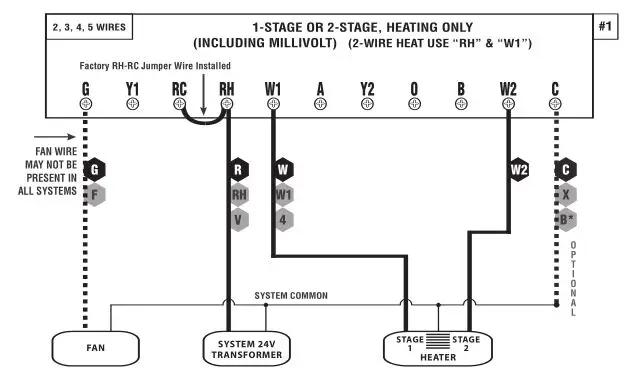
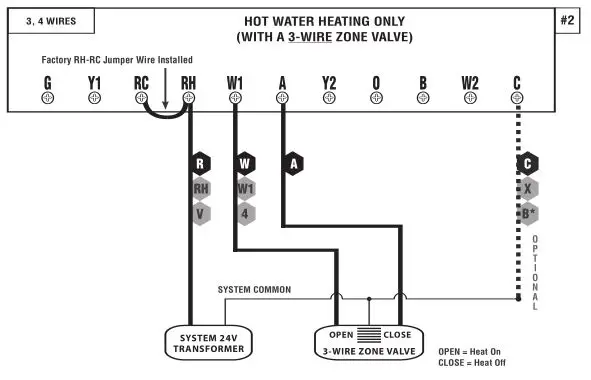
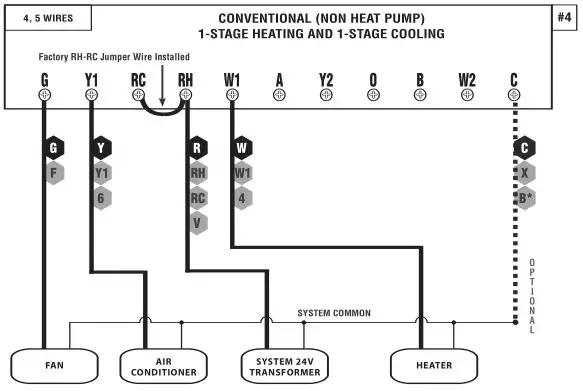
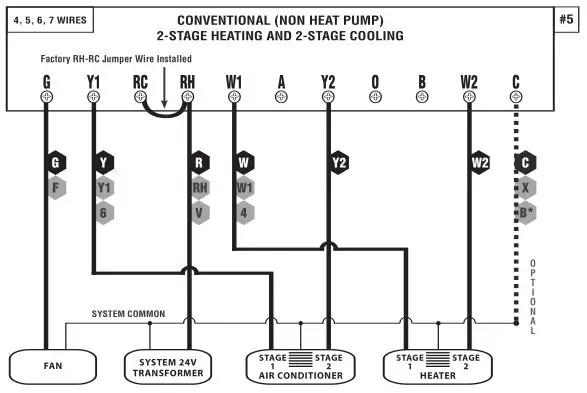
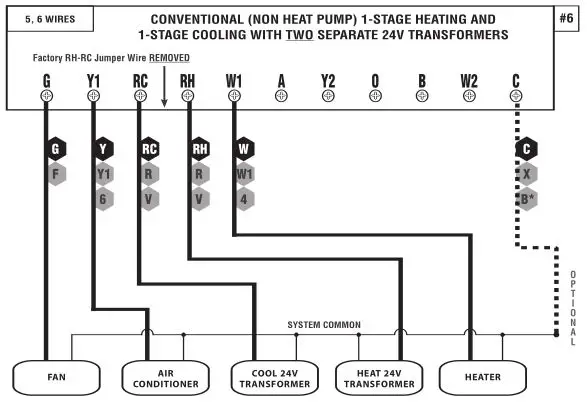
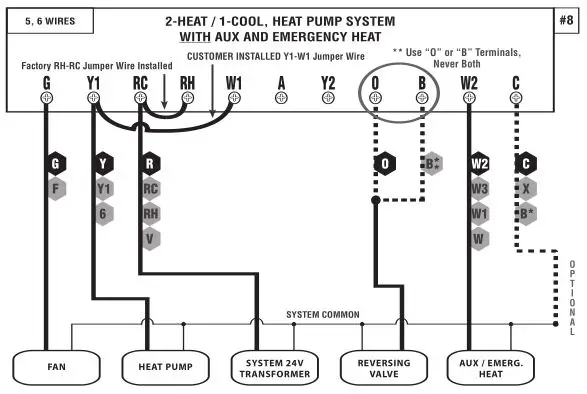
NOTE: THE BLACK TERMINAL LETTERS ARE TYPICAL, GRAY TERMINAL LETTERS ARE BRAND SPECIFIC